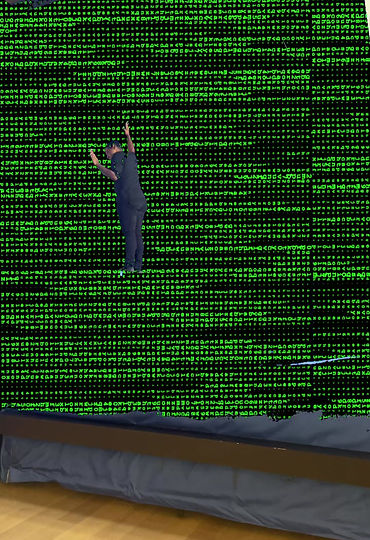VOID
Site-specific Installation, 2021
VOID is a site-specific installation by artist Ira Lombardia designed in collaboration with Studio MAPAa as part of the artist’s first solo exhibition in the US. SCAD Museum of Art in Savannah, Georgia, USA. It consists of building a physical frame, a temporary stage for social (media) interaction. This ephemeral construction digs into Lombardia’s current practice; in particular, she reflects on the impact and value of photographic art documentation and how those images are produced, distributed, and consumed to grasp how these fluctuations affect the meanings and ideologies hidden behind pictures and define our idea of art. The concept of documentation and performance art is reinterpreted by Lombardía, diluting the roles between artist and audience. The architectural proposal was designed to allow participants to jump from a wooden structure and land safely on an inflatable surface. In addition, the blue color acts as a chroma, and the sculpture becomes a set. Participants can easily record and customize their experience by downloading and using the app VOIDX, which was created for this installation and developed by Amir Ahmadi.
VOID Solo Show, 2021 SCAD Museum of Art, Curator: DJ Hellerman, Savannah, GA, USA
This work references Yves Klein’s Leap Into the Void (1960), which Lombardía finds to be an apt metaphor for her experience as an artist: looking, experiencing, flying, and falling. In October 1960, Klein hired Harry Shunk and János (Jean) Kender to make a photograph in which Klein “re-created” a jump from a second-floor window that he claimed to have executed earlier that year. This second leap was made from a rooftop in the Paris suburb of Fontenay-aux-Roses. In the resulting image, Klein appears to free fall onto the street below. In reality, however, a group of the artist’s friends held a tarpaulin to catch him. To produce this illusion, two negatives — one showing Klein leaping, the other showing the surrounding scene (without the onlookers and tarp) — were merged during printing to create a seamless “documentary” photograph, a precursory method that anticipated Photoshop decades before its development. Klein then created a fake newspaper, Dimanche – Le Journal d’un Seul, to distribute the image to the public at Parisian newsstands. Influenced by Klein, as well as Alan Kaprow’s Happenings, the work of Argentinian artist Oscar Masotta, and Yoko Ono’s FLUXUS-inspired scores, Lombardía is engaged in questioning the role of the artist, the power of photography, and the transformation of objects into images and vice versa. With Void, she invites visitors to participate in the creative process,orchestrating an experience that encourages the sharing of images through social networks, ultimately blurring the lines between art documentation and self-presentation as powerful modes of representation. Some museums try to regulate photography, and visitors are often not allowed to take photos in the galleries. Here, however, visitors are encouraged to take photos, as their participation is necessary for Void to be fully realized, just as collaboration and social relationships are needed for any creative act. Lombardía explains, “Our challenge now is to explore the new photographic uses that have arisen thanks to digital photography, the internet, and social networks. We cannot ignore the impact that these new practices have on all aspects of our lives, including art. The rules of the game have changed and they are here to stay; as an artist I feel a responsibility to study the past in order to be able to work on the conflicts of the present. The idea of aura or even index is obsolete, and that leaves a theoretical vacuum. For the first time, photography has gained ground over the textual, and images are ahead of theory.” DJ Hellerman Curator, SCAD Museum of Art
Curator: DJ Hellerman
Assitant Curator: Britanny Richmond
Architect: Studio MAPAa
Developer VOIDX: Amir Ahmadi
UX Design: Brie Nestler
Art Direction VOID X and Exhbition Design: Jane Zash
Photo Credits: SCAD Museum of Art






Leap Into The Void, Yves Klein. Picture by János Kender and Harry Shunk.1960.











